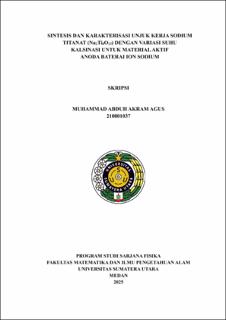Sintesis dan Karakterisasi Unjuk Kerja Sodium Titanat (Na2Ti6O13) dengan Variasi Suhu Kalsinasi untuk Material Aktif Anoda Baterai Ion Sodium
Synthesis and Performation Characterization of Sodium Titanate (Na₂Ti₆O₁₃) as an Anode Material for Sodium-Ion Batteries Under Varying Calcination Temperatures

Date
2025Author
Agus, Muhammad Abduh Akram
Advisor(s)
Humaidi, Syahrul
Metadata
Show full item recordAbstract
In this study, the synthesis and performance characterization of Sodium Titanate (Na₂Ti₆O₁₃) were carried out to evaluate its potential as an anode material for sodium-ion batteries, with particular emphasis on the effect of calcination temperatures at 900°C, 950°C and 1000°C. The material was synthesized using a template-assisted hydrothermal method employing NaCl, citric acid, TTIP (Titanium(IV) isopropoxide) and ethylene glycol as precursors. The hydrothermal process was conducted at 150°C for 6 hours, followed by calcination at the specified temperatures for 3 hours. Characterizations were performed using X-Ray Diffraction (XRD) to determine crystal structure, Scanning Electron Microscopy coupled with Energy Dispersive Spectroscopy (SEM-EDS) for morphological and elemental analysis, and Brunauer–Emmett–Teller (BET) analysis to assess surface area and porosity. The electrochemical performance was evaluated through Cyclic Voltammetry (CV) in a half-cell configuration (Na2Ti6O13||Na) using 1 M NaClO₄ in an EC:DEC (1:1) electrolyte solution. XRD results confirmed the successful formation of Na₂Ti₆O₁₃ as the dominant phase with a monoclinic crystal structure (C2/m) across all samples. SEM analysis revealed that the most uniform and well-defined rod-like morphology was achieved at a calcination temperature of 950°C. BET analysis indicated that the NTO-950 sample possessed the highest specific surface area, measuring 3.707 m²/g. CV measurements demonstrated that NTO-950 exhibited the highest peak current and the largest pseudocapacitive contribution, indicating superior redox stability. In contrast, NTO-900 showed lower current response, while NTO-1000 suffered performance degradation due to excessive sintering. Therefore, calcination at 950°C is identified as the optimal condition for synthesizing sodium titanate with enhanced crystallinity, favorable morphology, and superior electrochemical properties as an anode material for sodium-ion batteries.
Collections
- Undergraduate Theses [1380]
